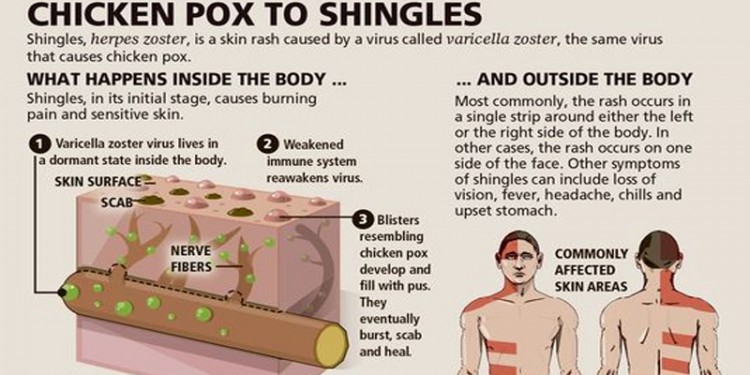Shingles: What You Need to Know

What Is Shingles?
Shingles is the clinical presentation of rash blisters occurring in a single, localized area of the body that follows a nerve distribution. It is the Chicken Pox virus that comes out of remission in only a certain part of your body. Chicken Pox is a virus that lasts 10-14 days, with breakouts in a vesicular rash (a vesicular rash is a rash that contains little “vessels” filled with fluid like small blisters.)
Once this virus runs its course, it goes into a latent state possibly for the rest of that person’s life. For reasons unknown to us, the virus can come out in certain people at certain times in their lives. Before the rash appears, pain is the first symptom that people usually report. They can also experience itching, burning and tingling. When virus finally comes out, it causes a rash with blisters and within 14 days resolves itself once and for all.
Why Only in Patches?
Shingles usually follows a specific nerve pathway or distribution called “dermatomes” and it usually covers approximately three (3) of these dermatomes. For this reason, it often appears in a “belt”-like pattern. In addition, the rash only appears on one side of the body, not both.
The rash doesn’t cross the centerline of your body if you were to draw a line from the middle of your head vertically down to your toes. Culturing the vesicular fluid would confirm the diagnoses and most often the presentation from person to person is quite similar.
 Figure 1 Shingles
Figure 1 Shingles
How Do You Get Shingles?
In order to acquire shingles, you must have first have had Chicken Pox earlier in your life. In the event where someone has had a vaccination, it is possible to get shingles but he would first have to get Chicken Pox. It is the varicella-zoster virus causes both shingles and Chicken Pox.
 Figure 2 Chicken Pox
Figure 2 Chicken Pox
Statistics
The older you are, the more likely you are to get shingles. In fact 50% of cases are people over 70 years of age. Generally, shingles does not cause long-term problems, however, is important to note that an episode of shingles can leave someone with nerve pain called neuropathy. This pain is severe, unrelenting, and generally non-treatable except with pain medication or a nerve block. This is the reason for those 50 years or older (the standard used to be 60) now get a vaccine to boost one’s immune system. It is unknown why neuropathy occurs.
Treatment Options
Any medical illness that is self-limited like shingles generally does not require treatment. If treatment is sought, however, one is given an antiviral similar to that which we use to treat Herpes because shingles is in the same family as Herpes. If treatment begins within 24-48 hours, it shortens the symptom duration from 10-14 days to approximately 7 days. Thus, the therapy is really more of a convenience than anything else.
 Figure 3 Anterior Dermatomes
Figure 3 Anterior Dermatomes Figure 4 Posterior Dermatomes
Figure 4 Posterior Dermatomes
One thing, however, that is critical to note: if shingles occurs in the eye, this is very serious and can cause blindness. In this case, the patient would have to get the anti-Chicken Pox viral therapy.
Those with comorbidities (such as diabetes, heart disease or other health-related problems) are really no more at risk than anyone else. Only those with AIDS are at greater risk but beyond that, no increased risk factors exist.
Overall, shingles is nonthreatening and self-limited. It is only transmissible if the vesical breaks, and someone touches it with no history of ever being infected with Chicken Pox. Beyond that, it is generally an easy self-limited course.
One thing is for sure, shingles doesn’t happen twice: you may get it once and never again.
Learn More
Visit the Mayo Clinic’s page on shingles to learn more.



